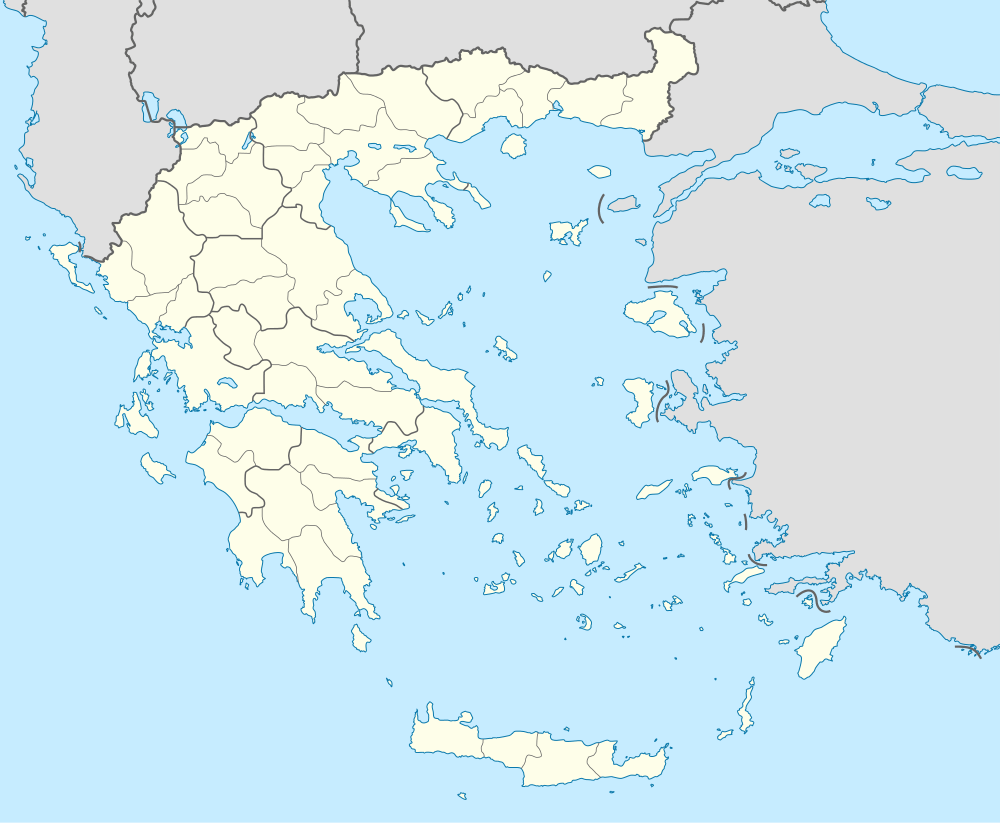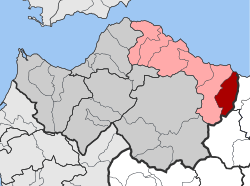Aigeira
| Aigeira Αιγείρα | |
|---|---|
 Aigeira | |
|
Location within the regional unit  | |
| Coordinates: 38°9′N 22°21′E / 38.150°N 22.350°ECoordinates: 38°9′N 22°21′E / 38.150°N 22.350°E | |
| Country | Greece |
| Administrative region | West Greece |
| Regional unit | Achaea |
| Municipality | Aigialeia |
| Districts | 11 |
| • Municipal unit | 103.65 km2 (40.02 sq mi) |
| Elevation | 10 m (30 ft) |
| Population (2011)[1] | |
| • Municipal unit | 2,626 |
| • Municipal unit density | 25/km2 (66/sq mi) |
| Community[1] | |
| • Population | 1,462 (2011) |
| Time zone | EET (UTC+2) |
| • Summer (DST) | EEST (UTC+3) |
| Postal code | 250 10 |
| Area code(s) | 26960 |
| Vehicle registration | ΑΧ |
| Website | www.aigeira.gr |
Aigeira (Greek: Αιγείρα) (IPA: [eˈʝira]) is a town and a former municipality in northeastern Achaea, West Greece, Greece. Since the 2011 local government reform it is part of the municipality Aigialeia, of which it is a municipal unit.[2] The municipal unit has an area of 103.646 km2.[3] The municipal unit stretches from the Gulf of Corinth, where the town Aigeira is located, to the mountains in the south. The town Aigeira is 26 km (16 mi) southeast of Aigio, 55 km (34 mi) northwest of Corinth and 55 km (34 mi) east of Patras. The Greek National Road 8A (E65 Corinth - Patras) and the railway Corinth - Patras run through the town.
Subdivisions
The municipal unit Aigeira is subdivided into the following communities:
- Aigeira
- Aiges
- Ampelokipoi
- Chrysanthio
- Exochi
- Monastiri
- Oasi
- Perithori
- Seliana
- Sinevro
- Vella
Historical population
| Year | Community | Municipality |
|---|---|---|
| 1981 | 1,320 | - |
| 1991 | 1,696 | 4,211 |
| 2001 | 1,673 | 4,503 |
| 2011 | 1,462 | 2,626 |
History
The area was settled in the 3rd millennium BC. The city was known as Hyperesia (Greek: Υπερησία, Hyperesia) during Homeric times. According to Pausanias, in 688 BC Hyperesia was threatened by a hostile army from Sicyon. The locals defended their city by placing burning torches on their goats' (aiges in Greek) horns. As a result, the invaders left in fear while the Hyperesians renamed their town Αigeira to honor the goats.[4]
The city was prosperous and was one of the twelve most important cities in the Achaean League. The city consisted of two parts: a port on the Gulf of Corinth and the upper town, 12 stadia (2 km (1.2 mi)) from the port. According to Pausanias, there were sanctuaries of Zeus and Athena as well as a temple of Artemis Agrotera in the upper town.[4]
Archaeology
The Austrian Archaeological Institute made excavations in Aigeira in 1916. The team with Otto Walter found the head of the statue of Zeus, which according to Pausanias was a work by the Athenian sculptor Euclid.[4] Walter also found the left arm, the finger at the right hand later.
From 1972, excavations led by Wilhelm Alzinger excavated the Mycenaean acropolis, the ancient theatre and several naiskoi next to the theatre (naiskos (small temple)). The floor of one of them is decorated with a pebble mosaic representing an eagle with a serpent. Also, the Tycheio (sanctuary of Tyche) described by Pausanias was uncovered next to the theatre. Further to the north, foundations of two small temples were explored by Anton Bammer. On the terrace north of the acropolis, a presumably public building with banqueting rooms and bathing facilities was located and excavated by Georg Ladstätter.
Sport
The town is home to the Aigeira Municipal Stadium. Its major soccer team is Thyella Aigeira. Aigeira is also home to non-league amateur football club Panaigeiratikos.
See also
References
- 1 2 "Απογραφή Πληθυσμού - Κατοικιών 2011. ΜΟΝΙΜΟΣ Πληθυσμός" (in Greek). Hellenic Statistical Authority.
- ↑ Kallikratis law Greece Ministry of Interior (Greek)
- ↑ "Population & housing census 2001 (incl. area and average elevation)" (PDF) (in Greek). National Statistical Service of Greece.
- 1 2 3 Pausanias, Description of Greece, 7.26
External links
- Austrian Archaeological Institute, Research in Aigeira
- Österreichische Akademie der Wissenschaften The Mycenian settlement in Aigeira (German)
- GTP - Ancient Aigeira
- GTP - Aigeira
- GTP - Municipal unit of Aigeira
- SC Panaigeiratikos
 |
Akrata | Gulf of Corinth | Evrostina |  |
| Akrata | |
Evrostina | ||
| ||||
| | ||||
| Akrata | Feneos | Feneos |